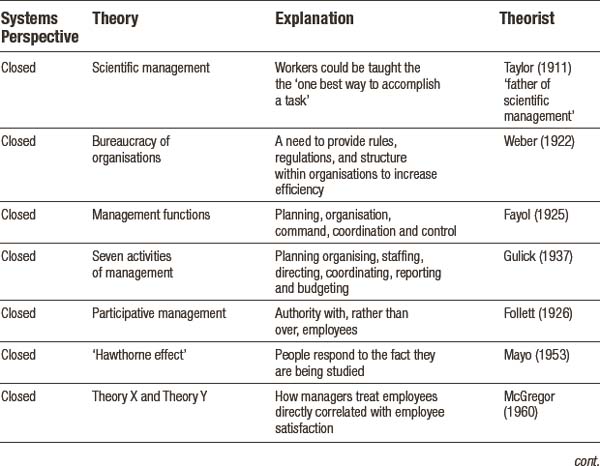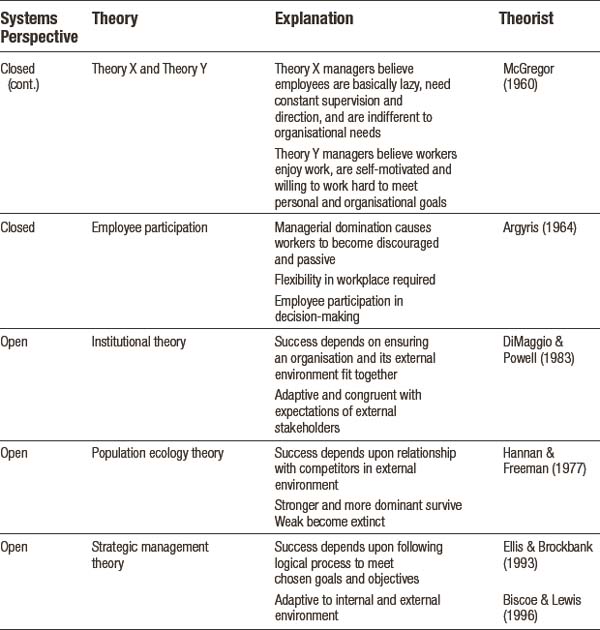CHAPTER ONE Leading and managing in nursing practice
Concepts, processes and challenges
PRINCIPLES OF LEADERSHIP AND MANAGEMENT THEORY
Differences between leadership and management
Theorists continue to debate the relationship between leadership and management. Some theorists argue that leadership is simply one of the many functions of management (Tranbarger 1988), while others assert that leadership requires an extended range of complex skills and that management is simply one role of leadership (Gardner 1986).
When examining the literature on both leadership and management it is evident that both concepts have a symbiotic or synergistic relationship with each other. That is, in order for managers and leaders to function effectively, the two concepts must be integrated (Marquis & Huston 1996). Traditionally, strong management skills have been highly valued within health care organisations. However, more recently the demand for leadership skills has gained prominence. We will return to the difference between leadership and management later in this chapter.
Development of management theory
In order to understand health care organisations, it is necessary to clarify some of the different theoretical approaches used to describe organisations in general. Systems theory offers a range of insights into the functions of organisations. Sampson and Marthas (1990) describe systems theory as having specialised components that work together interdependently to form an overall balanced framework.
Organisations conduct their everyday activities by taking either an open systems or a closed systems approach (see Table 1.1). The open systems approach places importance on the links between organisations, emphasising the need for ensuring open lines of communication. They must also be adaptative, innovative and flexible (Shortell & Kaluzny 1997). On the other hand, organisations with a closed systems approach tend to function independently from the external environment and have processes and procedures set in place to ensure that the organisation’s internal efficiency reaches its full potential.
Table 1.1 Open and closed systems functions
| Type of system | Function |
|---|---|
| Open systems | |
| Closed systems | Organisation functions independently of external environment |
A brief summary of the various theoretical approaches undertaken during the development of management theory is presented on the following pages.
Scientific management
In the late nineteenth century, Frederick W. Taylor was working as a mechanical engineer in a steel plant in Pennsylvania. At the time, ‘systematic soldiering’ was rife— workers would undertake the least amount of work possible to achieve minimum standards. Taylor (1911) believed that the introduction of ‘one best way to accomplish a task’ would ensure workers achieved an agreed-upon standard, which in turn would lead to increased productivity.
Identification of management functions
In 1925, Fayol described the management functions of planning, organisation, command, coordination and control. Gulick (1937) extended this work by introducing the ‘seven activities of management’—planning, organising, staffing, directing, coordinating, reporting and budgeting. These theorists also took a closed systems perspective on organisations.
Human relations theory
In the 1920s the introduction of the assembly line meant that great numbers of relatively unskilled workers were working in large, complex factories on specific tasks. There was great worker unrest, causing human relations theorists to examine what motivated workers to work. M. P. Follett (1926), in her essay entitled ‘The Giving of Orders’, asserted that managers should have authority with, rather than over, employees. Follett was one of the first theorists in this era to argue for what is known today as ‘participative decision-making’.
Other human relations theorists such as Mayo (1953), McGregor (1960) and Argyris (1964) all expanded upon her work. Mayo identified the ‘Hawthorne effect’. He found that employees increased their productivity levels when special attention was paid to them, regardless of any other changes in their working environment. He noted that people responded to the fact that attention was being paid to them and that they would continue to display the behaviour needed to continue to gain the attention. McGregor (1960) extended upon these concepts by labelling managers as either Theory X or Theory Y managers, depending upon their views of how employees performed their activities (see Table 1.2). Argyris (1964) reinforced the theories of Mayo and McGregor by arguing that managerial domination leads workers to become discouraged and passive, therefore creating low productivity levels and reduced profits. He believed this would subsequently lead to troublesome employees, and eventually an increased turnover of staff.
The human relations theory of organisations is based upon a static environment where structures are organised around the professional disciplines. On its own it is not sufficient to describe complex health care organisational structures. Nor does it adequately provide a means of understanding and managing the changes that are taking place in today’s health care organisations (Lloyd & Boyce 1998).
Institutional theory
Institutional theory takes an open systems perspective of organisations. It examines how organisations succeed by ensuring they fit together with the external environment (DiMaggio & Powell 1983; Powell & DiMaggio 1991). Powell & DiMaggio (1991) argued that organisations gain legitimacy from key external stakeholders as they adopt norms, rules and values that reflect the stakeholders’ belief systems. By adapting to the external stakeholder environment, organisations signal their congruency with the expectations of stakeholders, such as funding agencies, governments, professional bodies and customers (Daft 1998).
Population ecology theory
Subsequently, a gradual evolution of organisational structural changes will occur within the organisation in order to accommodate the complexities of the external environment. Daft (1998) notes that niche markets are often left open in unexploited environments.
Strategic management theory
Strategic management theory is yet another open systems approach to organisations. The organisations that use this theory seek to incorporate the internal and external environment into their planning process as they strive to meet targeted objectives. Strategic management theory is commonly used in health care organisations because of the need to try and balance limited resources while ensuring that patient care is not threatened. These organisations take an ordered approach to the planning process and define and regularly monitor their chosen organisational goals and objectives to ensure they meet budgetary performance targets (Biscoe & Lewis 1996; Ellis & Brockbank 1993).
An overview of these various theoretical approaches is presented in Table 1.2. More recently, we have seen organisations moving towards more open systems perspectives in an endeavour to adapt to the ever-changing environment. This paradigm shift will be discussed in the following section.
OLD AND NEW PARADIGMS IN MANAGEMENT OF NURSING PRACTICE
In examining the functions of leadership within an organisation, Stout-Shaffer and Larrabee (1992) identified five paradigm shifts to transform health care organisations into the new millennium (See Table 1.3). In the past, organisations were characterised by centralised hierarchies, with power vested in the management. Employees were skeptical of management and distrusted it. Health care organisations undertook strategic planning activities in isolation from patients and set benchmarks for planned productivity and efficiency within their own organisations in isolation from the external environment.
Table 1.3 Paradigm shifts transforming health care organisations
| Past | Future |
| Centralised hierarchies | Semi-autonomous work units |
| Power resting with management | Empowerment of all employees |
| Distrust of management | Trust |
| Planning for patients | Planning with patients |
| Quantitative productivity | Intuition and creativity |
Source: Stout-Shaffer & Larrabee (1992, pp.54–8).
Stay updated, free articles. Join our Telegram channel

Full access? Get Clinical Tree










